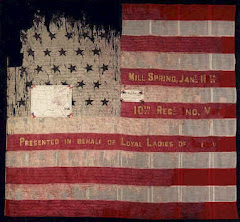
Officers of the Army and Navy who served in the Civil War, Edited by Lt. Col. Wm H. Powell, U.S. Army, Published By L.R. Hamersly & Co., Philadelphia, PA., 1893, p. 129
Colonel D.H. Patton, whose proudest title is that of "The Hero of Jonesborough's Skirmish-Line," was born November 26,1837, near Flemingsburg, Kentucky. His boyhood days were spent upon the farm and attending the village schools. In 1857 the family moved to Indiana, taking up residence at Waveland, Montgomery County, where David, then in his twentieth year, entered the Waveland Collegiate Institute, completing a scientific course in 1860, when he immediately entered upon the study of medicine. While engaged in the study of his chosen profession, Fort Sumter was bombarded; following this came the disastrous defeat of the Federal forces at Bull Run. The future colonel laid aside his books, relinquished his cherished ambitions for the present, and with twelve others hastened to New Albany to join the Thirty-eighth Indiana, already organized and ready for the field. The regiment passed into Kentucky, and after innumerable skirmishes and marching and countermarching for nearly eighteen hundred miles they were face to face with the Confederates at Perryville, where a battle was fought. It was the fate of the thirty-eighth Indiana to bear a conspicuous part on that field, where their percentage of loss was as great as that of either of the contending armies at Waterloo. Of the color-bearer and guard, Patton and Sullivan alone stood erect, and the former, as Colonel Scribner will testify, could touch the colors any time during the engagement. Of the seven that lay upon the ground, five were killed outright and one dangerously wounded. The flag-staff was shot in two twice, and the colors were shot into shreads on that day.Their next severe engagement was Stone River, where the colors were pierced by thirty-one balls, and private Patton again distinguished himself so much that he was promoted. The regiment participated in the capture of Lookout Mountain and the "battle in the clouds," in which they again distinguished themselves. The regiment served in the Atlanta campaign, participating in all the battles till that city was taken. In the battle of Jonesborough Lieutenant Patton rendered signal service, and recived the highest praise of his commanding officer, being styled "the hero of Jonesborough's skirmish-line."
-To fully understand the importance of the service rendered, it must be understood that Jonesborough was the key to Atlanta, and that certain works lying in front of Carlin's brigade were the key to Jonesborough, and Carlin's brigade was ordered to take the works. Two regiments were ordered to attack, but were repulsed; but they had succeeded in getting close enough to the works to learn that an abatis lat just in front of it that would have to be torn away to make room for the assaulting colimn. General Carlin ordered Lieutenant-Colonel Griffin to take the Thirty-eighth, as it was all there was left, and take the works. Colonel Griffin ordered Company G, Captain H.F. Perry, and Company H, Lieutenant David H. Patton, as skirmishers, to take advantage of the smoke and gathering shades of evening, reserve their fire, to move noiselessly as possible, tear away the abatis, and open a way to carry the works. Captain Perry fell early in the advance, but lieutenant Patton and skirmishers cleared away the abatis, and the Thirty-eighth carried the works. To the bravery of Colonel Patton on that occasion, Colonel Griffin, in his farewell address to the regiment, feelingly alludes when he says, "To the brave boys I can but say that everything is due to their valor on the field; and remember that you have a leader in the commander of Jonesborough's gallant skirmish-line," meaning Captain Patton, who was then the ranking officer and in command.After the fall of Atlanta the Thirty-eighth went with Sherman to the sea; from Savannah they marched into North Carolina and fought the battle of Bentonville, where the senior officer, Captain Lowe, fell, leaving the regiment in command of Captain Patton, who brought it to victory.While in camp at Goldsborough, Captain Patton was elected colonel by his brother officers, and received his commission as such. His military record is a heritage that his children will prize above gold and silver, and will stimulate them to noble deeds and aspirations.
-After the close of the war, having been mustered out with his regiment, Colonel Patton resumed the study of medicine, graduating from the Chicago Medical College in 1867, since which time, up yo 1890, he has been in the continuous practice of his profession at Remington, Indiana. He is at present a member of Congress from the tenth Indiana District, and is well and favorably known.


No comments:
Post a Comment